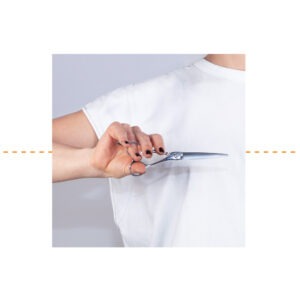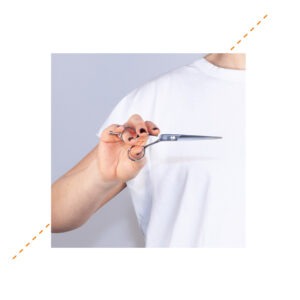FREQUENTLY ASKED QUESTIONS
Below are some frequently asked questions, you may find the answer for yourself. Find the answers about the brand, our scissors, manufacturing process, payment options, how to service your Kasho and much much more. We have tried to incorporate as may questions as possible in order to help you make an informed decision about your Kasho purchase.
→ WHAT’S KASHO KNOWN FOR?
Kasho is known for producing high-quality professional hairdressing and barbering scissors and cutting tools, which has over the years expanded to also include electrical tools, combs and other high quality accessories. Kasho is part of the Japanese legacy KAI company, which has over 100 years of experience in designing, manufacturing and forging the highest level of quality steel. KAI has its roots stretching back to the days of the Samurai. KAI also manufactures world leading fabric shears, used by high-end fashion houses, furniture makers and car manufactures, like Aston Martin and Rolls Royce. KAI also has an extensive range of top-end professional kitchen knives, used globally by some of the leading chefs. Kasho, as a sub-brand to KAI is the hairdressing world leader of professional scissors.
Some key points
Japanese Craftsmanship: Kasho scissors are often associated with Japanese craftsmanship, known for its precision and attention to detail. Japanese scissors are highly regarded in the hairdressing industry for their sharpness and durability.
High-Quality Materials: Kasho uses high-quality materials in the manufacturing of our scissors. This includes premium stainless steel and alloys that contribute to the sharpness and longevity of the cutting edge.
Innovative Design: The brand is known for its innovative scissor designs. This may include ergonomic handles for comfort during prolonged use, as well as unique blade designs to enhance cutting performance and unique patented screw systems, like our disc operating system.
Handcrafted Scissors: Many Kasho scissors are handcrafted, reflecting a commitment to traditional craftsmanship. Handcrafted scissors are associated with a higher level of precision and attention to detail compared to mass-produced alternatives.
Versatility: Kasho offers a range of scissors designed for various cutting techniques and styles, catering to the diverse needs of hairdressers and barbers.
Limited Editions: Kasho occasionally releases limited-edition scissors, adding an element of exclusivity to their product line. These limited editions may feature special designs, materials, or finishes.
For life: When purchasing a Kasho scissor you are purchasing a tool to span the length of your career. When properly taken care of, and serviced, the quality of a Kasho keeps lasting, and lasting.
→ WHAT’S A BALL-BEARING SCREW SYSTEM?
This sophisticated screw system, found at the heart of the scissor, is responsible for incomparably smooth cutting operation. By using an enclosed ballbearing unit, friction between the blades is brought to an absolute minimum. This in turn greatly reduces hand fatigue from the motion of opening and closing your scissor day-in and day-out because you don’t need to apply any additional cutting pressure. Being an enclosed unit, the ballbearing is sealed to make it free from collecting hair, dust and other substances so that nothing affects the precise movement of the scissors.
Both Millennium and XP feature a more complex Disc Operation System which, in addition to the enclosed ballbearing unit, contains a special spring and a synthetic disc that ensures uniform pressure. Thanks to the replaceable synthetic disc, friction and wear between the blades is reduced even further for a considerably longer lifespan than conventional scissors.
→ DIFFERENCE BETWEEN JAPANESE AND GERMAN SCISSORS?
Globally there are two countries known for its production of sharp metal, from scissors to surgical knives. Japan and Germany. Of the two, Japanese steel is known to be of a higher quality coupled with a far reaching heritage sharp metal production. The sharp edge is based on the type of metal used as well as the process I which it is forged. But let’s look at the four key areas of a scissor.
Steel Composition: Japanese scissors commonly use high-quality steel with a focus on high carbon content. Additional elements like cobalt, nickel (small amount and does not have an impact on allergies), and other alloys may be incorporated to enhance sharpness and edge retention. German scissors often use stainless steel with a composition that includes elements like chromium, molybdenum, vanadium, and carbon. This composition is chosen for its corrosion resistance.
Hardness: Japanese scissors are known for their high hardness, often ranging from 58 to 62 HRC and sometimes higher. This high hardness contributes to exceptional sharpness, making them well-suited for precision cutting. German scissors typically have a lower hardness compared to Japanese scissors. They are often in the range of 52 to 56 HRC (Rockwell Hardness C scale).
Blade Design: Japanese scissors typically have a thinner and lighter blade design. The blades may be flatter and have a more straight or convex profile. This design is advantageous for tasks that require precision and detailed cutting. German scissors often have a more robust and heavier blade design. The blades may be thicker, and the cutting edge may have a more curved profile.
Edge Angle: Japanese scissors commonly have a narrower edge angle, often around 15 to 20 degrees. The narrower angle allows for a sharper edge, which is beneficial for precise and intricate cutting. German scissors usually have a wider edge angle, typically around 30 degrees or more. This wider angle contributes to durability but may sacrifice some cutting precision.
→ WHAT’S THE DIFFERENCE BETWEEN STRAIGHT & OFFSET?
The terms “straight” and “offset” refer to the design of the scissor handles. These handle designs are important considerations for you as a hairstylist, as they can affect comfort, ergonomics, and cutting performance. As everything, the scissor industry has evolved and our understanding of the importance of ergonomic design to alleviate shoulder tension, hand fatigue and other known hard wearing physical traits associated with hairdressing. Offset is a more ergonomic approach to cutting. If someone has been cutting with a straight scissor for years, it will take between 3-5 cuts to get used to cutting with an offset scissor, but once this adaptation has taken place, there will be a radical reduction in arm, shoulder and neck tension.

Straight

Semi-Offset

Offset
→ WHAT’S VG10 STEEL?
While VG-10 steel is more commonly associated with professional Japanese kitchen knives, it has through KAI, the parent brand of Kasho, also found its way into the production of our high-quality professional hairdressing scissors. The “VG” in VG-10 stands for “V Gold,” and is a type of stainless steel that originates from Japan. The properties that make VG-10 steel desirable for professional chef knives, such as its hardness, edge retention, and corrosion resistance, is also beneficial in the context of hairdressing scissors.
Hardness: VG-10 is known for its high hardness, typically ranging from 59 to 61 HRC (Rockwell Hardness C scale). This level of hardness allows for excellent edge retention, meaning the blade can maintain its sharpness through extended use.
Edge Retention: One of the standout features of VG-10 steel is its impressive edge retention. This makes knives made from VG-10 particularly suitable for tasks that require prolonged sharpness, such as slicing and precision cutting.
Corrosion Resistance: VG-10 steel has good corrosion resistance due to its chromium content. This property is essential for kitchen knives, as they are often exposed to moisture and acidic substances during food preparation.
Sharpness: VG-10 can be sharpened to a very fine edge, and it is known for its ability to take and hold a sharp edge, contributing to the precision and cutting performance of knives made from this steel.
→ WHAT’S KASHO DAMASCUS STEEL
For centuries, Japan’s Master Smiths have fashioned blades from alternating layers of steel, each little thicker than a human hair. This superb technique, known in the West as Damascus forging, gives each blade its hallmark strength and intricately graceful patterning. Each piece in Kasho’s Damascus Series is perfectly crafted, yet beautifully individual. The blades are crafted from eight layers of premium V10 cobalt alloy steel, resulting in ultimate sharpness and extremely powerful cutting.
Thanks to hand-finishing, the unique Damascus patterning promises a one-of-a-kind scissor. And, with Kasho’s clever ball bearing system integrated with Flat Screw technology, every cut is always silky smooth.

→ WHAT’S THE SINTERED STEEL IN OUR MILLENNIUM SCISSOR?
Sintered steel is made through a process called sintering. In simple terms, sintering is a way to make more complex items by pressing together powdered metal into a shape and heating it up, but not melting it. The result is a solid piece of metal that keeps its shape but is denser, stronger and lighter among a few of the better properties.
Sintered steel is used in the Millennium scissor because it allows us to created a stronger, harder metal, whilst creating a lighter scissor required for precision work. The metal structure coupled with the patented disc operating system creates a lightweight scissor with unprecedented sharpness and ease of use.
→ HOW OFTEN SHOULD I SERVICE MY KASHO
Just like a car, your scissor should be serviced every 1-2 years. A KASHO scissor should always be serviced by a KASHO artisan technician. Our service includes a thorough pre-service inspection, followed by a deep polish to correct any edge faults, ensuring the renowned KASHO sharpness is maintained. We then check on balance, stopper, centre assembly and finger rest (if fitted) and make any required corrections and/or replace any parts. All scissors are then tested both wet and dry, cleaned, oiled and returned back to you in immaculate condition. To book your service click here.
→ DO YOU OFFER FINANCE?
We work with Klarna to offer you a variety of payment methods. The payment methods you can choose from are: Pay now (card payments), Pay in 30 days (invoice), Pay in 3 instalments and Financing (instalment plans of 6, 12, 24 and 36 months with flexible payments). Once you choose Klarna as your payment option at checkout you will be taken to the Klarna website/portal, which is completely independent from Kasho, as is their application process.


